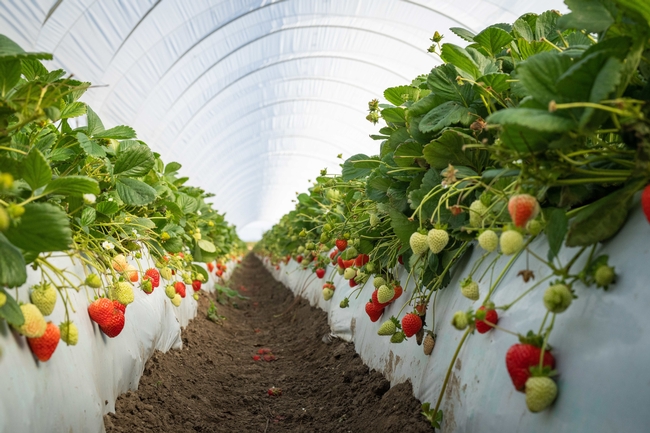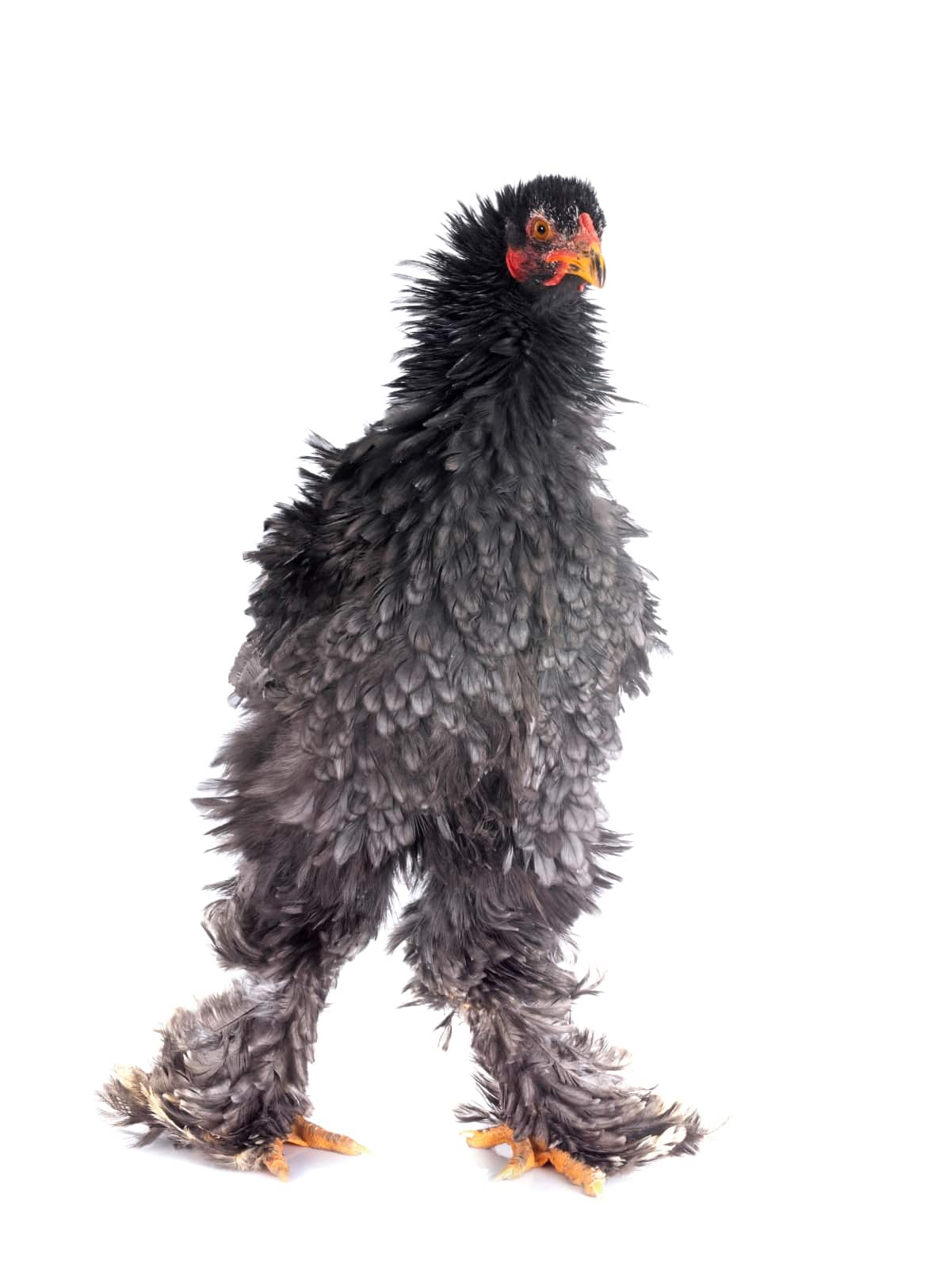UC Davis releases 5 strawberry varieties resistant to deadly fungal diseases
UC Eclipse strawberries grown in Santa Maria are resistant to the soil-borne disease Fusarium wilt. Photo by Jael Mackendorf/UC Davis
Strawberries selectively bred for their resistance to Fusarium wilt and their high yieldsThe University of California, Davis is releasing five new strawberry varieties that resist the soil-borne disease Fusarium Wilt, have high yields and better fruit quality.
UC Eclipse, UC Golden Gate, UC Keystone, UC Monarch, and UC Surfline will be available for sale at Foundation Plant Services California nurseries in April.
About 88% of the strawberries grown in the country come from California. Fusarium wilt is one of the most common causes of crop loss and death, yet 55 to 59 percent of cultivars planted in the state since 2014 have not been resistant, according to a UC Davis study.
This is the first version of the UC Davis strawberry breeding program where all cultivars have resistance to Fusarium wilt. They are intended to replace sensitive plants on the market such as Monterey, UCD Royal Royce and UCD Valiant.
Monarch was also developed specifically as a prototype for mechanical harvesting - another first for the breeding program, which dates back to the 1930s and has released 72 patented cultivars over the decades.
"These provide the same or better yield and they are resistant to Fusarium," said Steve Knapp, professor emeritus in the Department of Plant Science and director of the UC Davis Strawberry Breeding Program. “They have a better collection of traits. They are superior.

UC Monarch strawberries have long fruit clusters, or stems, which make picking or eventual mechanical harvesting easier. Photo by Cindy Lopez Ramirez/UC Davis
Dangerous pathogen
Fusarium wilt didn't pose much of a threat to strawberry crops until the fumigant methyl bromide was phased out in the United States in 2005. But the pathogen has always been in the soil and cases of wilting have appeared. a year later and has increased over time, raising concerns that a Fusarium wilt pandemic could destroy the crop in California.
"The disease has spread quickly and we need to respond quickly to meet the need," said Glenn Cole, breeder and field manager at the Strawberry Breeding Program.
Knapp said the program tries to "encourage people to consider things like disease resistance" and regularly invites growers and other experts to events showcasing research breakthroughs and improved cultivars.
Varieties for the seasons
The new strawberry varieties each have improved flavor and characteristics that allow for nearly year-round growth around California, where an estimated 1.8 billion pounds of fruit are harvested each year. Some of the cultivars are suited to production in the southern part of the state while others do well in the long daylight hours of summer along the coast.
Eclipse, a "summer plant" cultivar, has the potential to increase grower profitability as it produces in fall and winter, and yields in research trials were 54% higher than those of similar cultivars. “We expect this cultivar to have broad commercial appeal,” Knapp said. "Eclipse will eclipse them all."
Golden Gate and Keystone are "Independent Today". These types of cultivars grow throughout the summer on about 60% of the strawberry-growing acres in the state. Surfline and Monarch “short day” plants are resistant to Verticillium wilt and Phytophthora crown rot.
Surfline and Eclipse are firmer and promise longer shelf lives. Monarch provides growers with improved fruit qualities over other mass-produced cultivars and has the characteristics needed for advances in mechanical harvesting, Knapp said.


UC Eclipse strawberries grown in Santa Maria are resistant to the soil-borne disease Fusarium wilt. Photo by Jael Mackendorf/UC Davis
Strawberries selectively bred for their resistance to Fusarium wilt and their high yieldsThe University of California, Davis is releasing five new strawberry varieties that resist the soil-borne disease Fusarium Wilt, have high yields and better fruit quality.
UC Eclipse, UC Golden Gate, UC Keystone, UC Monarch, and UC Surfline will be available for sale at Foundation Plant Services California nurseries in April.
About 88% of the strawberries grown in the country come from California. Fusarium wilt is one of the most common causes of crop loss and death, yet 55 to 59 percent of cultivars planted in the state since 2014 have not been resistant, according to a UC Davis study.
This is the first version of the UC Davis strawberry breeding program where all cultivars have resistance to Fusarium wilt. They are intended to replace sensitive plants on the market such as Monterey, UCD Royal Royce and UCD Valiant.
Monarch was also developed specifically as a prototype for mechanical harvesting - another first for the breeding program, which dates back to the 1930s and has released 72 patented cultivars over the decades.
"These provide the same or better yield and they are resistant to Fusarium," said Steve Knapp, professor emeritus in the Department of Plant Science and director of the UC Davis Strawberry Breeding Program. “They have a better collection of traits. They are superior.

UC Monarch strawberries have long fruit clusters, or stems, which make picking or eventual mechanical harvesting easier. Photo by Cindy Lopez Ramirez/UC Davis
Dangerous pathogen
Fusarium wilt didn't pose much of a threat to strawberry crops until the fumigant methyl bromide was phased out in the United States in 2005. But the pathogen has always been in the soil and cases of wilting have appeared. a year later and has increased over time, raising concerns that a Fusarium wilt pandemic could destroy the crop in California.
"The disease has spread quickly and we need to respond quickly to meet the need," said Glenn Cole, breeder and field manager at the Strawberry Breeding Program.
Knapp said the program tries to "encourage people to consider things like disease resistance" and regularly invites growers and other experts to events showcasing research breakthroughs and improved cultivars.
Varieties for the seasons
The new strawberry varieties each have improved flavor and characteristics that allow for nearly year-round growth around California, where an estimated 1.8 billion pounds of fruit are harvested each year. Some of the cultivars are suited to production in the southern part of the state while others do well in the long daylight hours of summer along the coast.
Eclipse, a "summer plant" cultivar, has the potential to increase grower profitability as it produces in fall and winter, and yields in research trials were 54% higher than those of similar cultivars. “We expect this cultivar to have broad commercial appeal,” Knapp said. "Eclipse will eclipse them all."
Golden Gate and Keystone are "Independent Today". These types of cultivars grow throughout the summer on about 60% of the strawberry-growing acres in the state. Surfline and Monarch “short day” plants are resistant to Verticillium wilt and Phytophthora crown rot.
Surfline and Eclipse are firmer and promise longer shelf lives. Monarch provides growers with improved fruit qualities over other mass-produced cultivars and has the characteristics needed for advances in mechanical harvesting, Knapp said.
What's Your Reaction?













![Three of ID's top PR executives quit ad firm Powerhouse [EXCLUSIVE]](https://variety.com/wp-content/uploads/2023/02/ID-PR-Logo.jpg?#)







